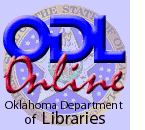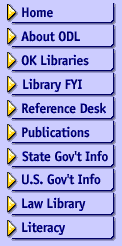

Oklahoma
Dept. of Libraries
200 NE 18th St
Oklahoma City,
Oklahoma
73105-3298
U.S. Government
Information
Division
(405) 522-3335
(405) 525-7804—FAX
Comments:
Steve Beleu,
director,
U.S. Government
Information
Division
| U.S. Government Information Division Links |
|
Oklahoma's Congressional Delegation
Oklahoma's Federal Information Libraries Special Collections in Depository Libraries U.S. Government Information Division Home
|
(Return to Federal Topics List)
You read or hear about them all the time—new recommendations about how to eat right, how much you should weigh, what your blood pressure should be, how much you should exercise, etc.
You may struggle to meet these guidelines. But the guidelines change, and in general, get tougher. You used to hear that you needed to exercise at least 30 minutes a day, and you did. But new guidelines say that you need to exercise at least an hour a day. It’s hard to keep up with the lifestyle changes that these recommendations ask you to make.
But medical guidelines keep changing as medical research suggests that they change. At first glance they seem to only get tougher and more difficult to meet. We seem to be dealing with ever-stricter definitions of what it takes to be healthy.
Unfortunately, deaths caused by the following four major maladies continue to increase. Health guidelines may change, but there’s a good reason for it.
These links will take you to two sets of information about each set of guidelines—1st to information about the guideline, and 2nd to easy-to-understand how-to information about trying to meet these guidelines.
For the public—
Blood
Pressure ...
from the National Heart, Lung, and Blood Institute, National Institutes
of Health
Categories
for Blood Pressure Levels in Adults
(ages 18 years and over)
Your Guide to Lowering High Blood Pressure
Body
Weight ...
from the National Center for Chronic Disease Prevention and Health Promotion,
Centers for Disease Control
Diabetes ...
from the National Institute of Diabetes and Digestive and Kidney Diseases,
National Institutes of Health
Eating ...
from the National Agricultural Library, U.S. Department of Agriculture
Dietary Guidelines for Americans
For healthcare professionals—The National Guideline Clearinghouse
www.guideline.gov
The Guideline Clearinghouse is a collaborative effort between the U.S. Public Health Service’s Agency for Health Research and Quality and the American Medical Association and American Association of Health Plans.
These health guidelines are meant to serve health professionals. These are evidence-based clinical practice guidelines that have been submitted by health care organizations, associations, medical societies, and federal agencies. It is updated every week.
Users can browse this list by disease, types of treatment or intervention, and by the name of the organization that submitted the guideline. Note that guidelines for the same diseases that have been submitted by different organizations can slightly differ in their treatment/intervention recommendations.
Users can create tabular comparisons of guideline summaries and syntheses or guidelines about similar diseases that will help them note areas of agreement and disagreement between these recommendations.
Note
to the general public who may access these guidelines:
Remember that they’re
written for healthcare professionals, often in clinical language, and that
recommendations from organizations may differ in their recommendations.
Consult you doctor for his advice about them—don’t practice self-diagnosis!
It’s dangerous!
(Return to Federal Topics List)
Copyright � 2012 - All Rights Reserved
Oklahoma Department of Libraries